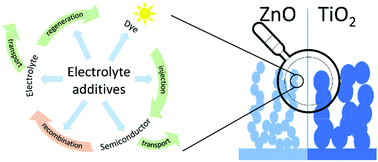Diverging surface reactions at TiO2- or ZnO-based photoanodes in dye-sensitized solar cells†
Abstract
Fast recombination of electrons from semiconductors with the oxidized redox species in the electrolyte represents a major bottleneck in the improvement of ZnO-based dye-sensitized solar cells (DSSCs). While processes at the semiconductor–electrolyte interface are well studied on TiO2 electrodes, the interactions of the ZnO surface with the electrolyte solution in DSSCs are less explored. This work aims at clarifying the different impact of the two contrasting redox couples I3−/I− or [Co(bpy-pz)2]3+/2+ (bpy-pz = bis(6-(1H-pyrazol-1-yl)-2,2′-bipyridine)) in electrolytes containing either no additives or Li+ ions and/or 4-tert-butlypyridine (TBP) in DSSCs using screen-printed nanoparticulate TiO2 (NP-TiO2) or electrodeposited ZnO (ED-ZnO) photoanodes sensitized with the indoline dye DN216. A detailed photoelectrochemical study is performed to investigate light absorption, charge transfer and mass transport in these cells. We demonstrate that the chemical nature of the semiconductor directly influences the affinity of adsorbates. This drastically influences the energy levels and recombination kinetics at the semiconductor–electrolyte interface, electron and ion transport in the porous system as well as light absorption of dye molecules by the Stark effect. The present investigation reveals the origin of major performance losses in DSSCs based on ED-ZnO photoanodes as well as the relevance of ionic interactions with NP-TiO2 photoanodes that can both serve as the starting point for rationally guided improvement of their conversion efficiencies.



 Please wait while we load your content...
Please wait while we load your content...